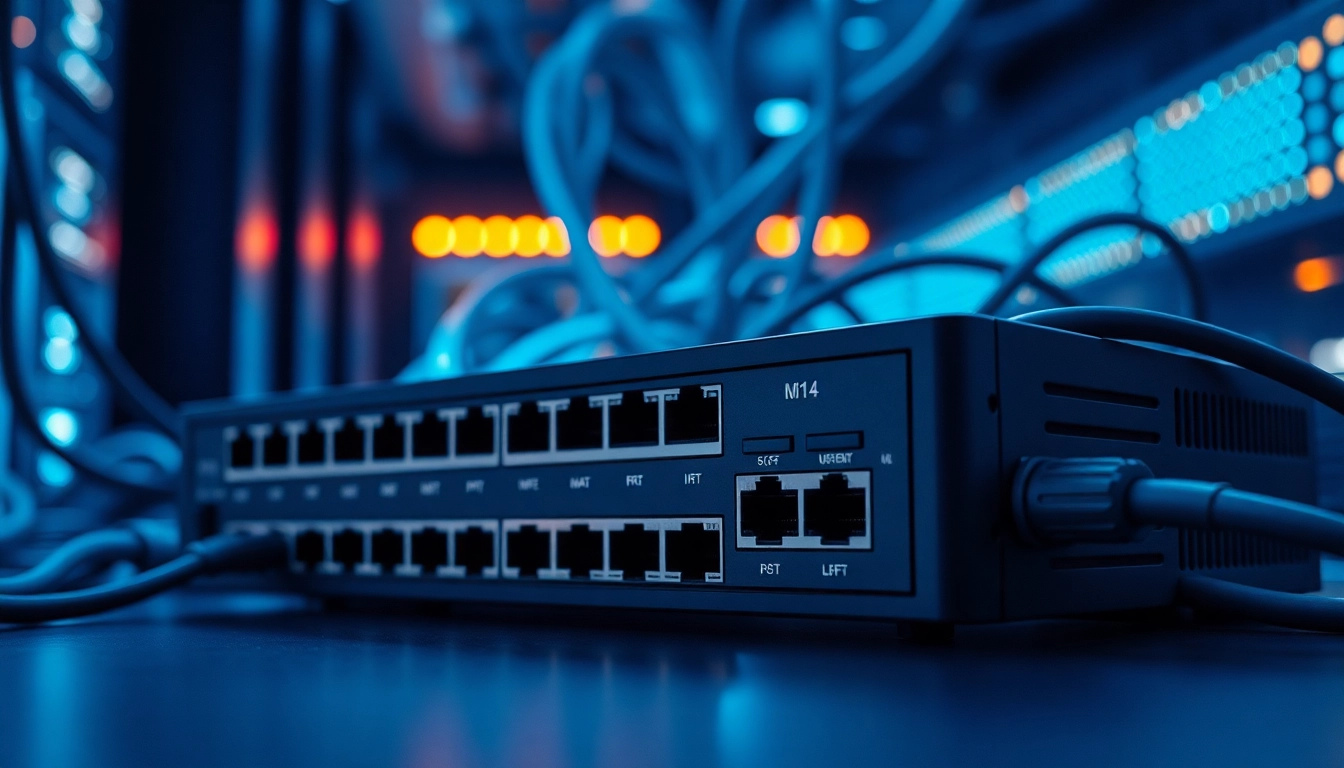Understanding Network Infrastructure Fundamentals
In today’s digital landscape, efficient and robust network infrastructure is the backbone of any organization’s operations. It integrates various technologies and processes that support reliable communication and data exchange between devices, users, and networks. As businesses increasingly rely on their digital capabilities, understanding the key components and functionalities of network infrastructure becomes crucial.
The Role of Network Infrastructure in Digital Operations
Network infrastructure serves as the foundational layer for all digital communications and operations. It comprises both hardware and software components that facilitate connectivity and data exchange among devices. With more organizations transitioning to cloud services, utilizing effective network infrastructure has become critical for ensuring smooth operation and user experience. This involves managing bandwidth, reducing latency, and optimizing the transmission of data. A well-designed network infrastructure not only enhances operational efficiency but also enables better service delivery, supports remote access, and fosters collaboration among teams.
Key Components of Network Infrastructure
Understanding the essential components of network infrastructure is vital for effective planning and management. The primary elements include:
- Routers: Devices that forward data packets between computer networks, playing a crucial role in directing traffic efficiently.
- Switches: Network switches connect devices within a network, allowing for the transfer of data among them while ensuring efficient communication.
- Cabling: Physical media like fiber optics or copper that facilitate data transfer between devices, essential for creating a reliable network.
- Firewalls: Security devices that monitor and control incoming and outgoing network traffic based on predetermined security rules, protecting the network from threats.
- Access Points: Devices that allow wireless clients to connect to a wired network, enabling mobility and flexibility in network access.
- Network Operating Systems: Software that manages and configures the hardware components and provides services to users and devices connected to the network.
Each of these components plays a pivotal role in ensuring that the network operates reliably and securely.
Common Network Infrastructure Models
There are several models of network infrastructure that organizations commonly adopt, depending on their unique needs:
- Traditional Infrastructure: Involves on-premises hardware and software, providing organizations complete control but requiring significant resources for maintenance and scaling.
- Cloud Infrastructure: Utilizes cloud-based services for storage and processing, enabling scalability and flexibility at a potentially lower cost compared to traditional models.
- Hybrid Infrastructure: Combines on-premises resources with cloud-based solutions, allowing organizations to choose where to run specific workloads for optimal performance and cost efficiency.
- Software-Defined Networking (SDN): Abstracts network control functions from the hardware, allowing for more straightforward management and automation of the network environment.
The selection of an appropriate model is critical for achieving strategic objectives and can greatly influence overall operational efficiency.
Assessing Your Current Network Infrastructure
Regular assessment of your network infrastructure is necessary to identify performance gaps, ensure resilience, and adapt to evolving business needs. Conducting thorough evaluations can help in aligning the infrastructure with organizational objectives and improving overall efficiency.
Evaluating Performance Metrics
Performance metrics play a significant role in determining the health and effectiveness of network infrastructure. Metrics such as latency, bandwidth usage, packet loss, error rates, and uptime should be monitored consistently. By analyzing these metrics, organizations can pinpoint areas of weakness and prioritize improvements. For example, high latency can indicate congestion or routing inefficiencies, whereas frequent packet loss may suggest hardware problems or need for upgrades.
Identifying Bottlenecks and Weak Points
Every network has its constraints and bottlenecks that can hinder performance. Identifying these weak points is essential for optimizing operations. Common issues arise from:
- Insufficient Bandwidth: Limited bandwidth can choke the data flow, resulting in slower speeds and increased latency.
- Hardware Limitations: Outdated or incompatible hardware can cause failures and inefficiencies.
- Poor Configuration: Misconfigured settings can lead to security vulnerabilities and connectivity problems.
By addressing these issues, organizations can significantly enhance their network performance and resilience.
Tools for Network Infrastructure Assessment
Several tools and software solutions are available to help assess network infrastructure. These tools can provide insights into the health and performance of various components, ensuring effective management. Some notable tools include:
- Pinger Tools: For checking latency and packet loss.
- Network Monitoring Tools: Such as SolarWinds and Nagios for real-time monitoring of network status.
- Bandwidth Analyzers: Tools like Wireshark for analyzing data packets and diagnosing network issues.
- Performance Testing Software: Solutions for simulating heavy loads on the network to identify breaking points.
Utilizing a combination of these tools can lead to comprehensive insights into network health, allowing for proactive maintenance and improvements.
Designing an Effective Network Infrastructure
Once the assessment is complete, organizations must design a network infrastructure that meets current and future needs. Good design principles can mitigate problems later, enabling seamless connectivity and enhancing overall performance.
Best Practices for Network Layout
A structured approach to network design can prevent bottlenecks and facilitate smoother operation. Some best practices include:
- Layered Design: Implement a hierarchical model that separates the core, distribution, and access layers, simplifying management and improving traffic flow.
- Redundancy: Incorporating redundancy minimizes risks by ensuring that a backup exists for essential components, like routers and switches.
- Scalability: Ensure that the design can accommodate future growth without significant reconfiguration.
- Documentation: Keep detailed documentation of your network layout, configurations, and changes to streamline troubleshooting and upgrades.
Following these practices will create a more resilient and manageable network environment.
Choosing the Right Hardware and Software
The selection of appropriate hardware and software is critical for the operational efficiency of network infrastructure. An inventory of needs based on assessment findings should guide these choices:
- Routers and Switches: Opt for devices that offer the required bandwidth, support the required protocols, and feature the necessary interfaces for connectivity.
- Firewalls and Security Tools: Select security solutions that match the organization’s security policies, ensuring it covers both internal and external threats.
- Management Software: Invest in software that provides intuitive monitoring and management capabilities for ease of use.
Balancing cost and performance is essential in these choices, as investing in quality components can lead to long-term savings and efficiency.
Implementing Security Measures
Security is now a significant concern, given the rise in cyber threats. Effective measures should be integrated during the design and implementation phases:
- Firewalls: Deploy firewalls as the first line of defense, controlling traffic between trusted and untrusted networks.
- Encryption: Encrypt data in transit and at rest to protect sensitive information from unauthorized access.
- Access Controls: Implement strict access control measures to restrict network access based on roles and responsibilities.
- Regular Audits: Conduct regular security audits and vulnerability assessments to ensure the network is secure and up to date.
By prioritizing security at every stage, organizations can safeguard their assets and maintain customer trust.
Implementing and Upgrading Network Infrastructure
Once the planning phase is complete, the next step involves implementing new solutions or upgrading existing network infrastructure while minimizing disruption to operations.
Planning for Deployment
A comprehensive deployment plan is crucial to ensure smooth integration of new systems. Some key components of an effective deployment plan include:
- Scheduling: Choose deployment windows that limit the impact on users, often scheduling during off-peak hours.
- Stakeholder Communication: Ensure all team members and stakeholders are informed of upcoming changes and understand their roles during the process.
- Backup Measures: Prepare backup solutions to maintain business continuity in case of unexpected issues during deployment.
Having a well-thought-out plan can mitigate risks associated with deployment and enhance overall project success.
Managing Downtime During Upgrades
Upgrading network infrastructure often necessitates some downtime. Managing this period effectively is essential to minimize inconvenience:
- Transparent Communication: Inform users ahead of time of potential downtime and expected consequences.
- Backup Workflows: Develop contingency plans to redirect work and ensure minimal disruption for critical operations during downtime.
- Staggered Upgrades: Consider rolling upgrades that allow segments of the network to remain operational while others are being upgraded.
By handling downtime responsibly, organizations can maintain user trust and ensure productivity remains high.
Training Staff for New Systems
Following implementation, ensuring that staff are adequately trained on new systems is critical for maximizing investment in network infrastructure. Effective training approaches include:
- Hands-On Training: Provide practical, hands-on experience with the new systems to increase familiarity and confidence among staff.
- Documentation: Offer clear, accessible documentation detailing processes and troubleshooting guides to support ongoing use.
- Continuous Support: Establish a support system for ongoing questions and concerns, ensuring staff has continuous access to knowledgeable resources.
Equipping staff with knowledge and confidence can lead to enhanced operational effectiveness and greater satisfaction with new infrastructure.
Measuring Success of Your Network Infrastructure
After upgrading or implementing a new network infrastructure, measuring its success is the next step. Evaluating various criteria can provide insights into its performance and effectiveness.
Setting Key Performance Indicators
Key Performance Indicators (KPIs) are essential metrics for assessing network infrastructure success. KPIs can include:
- Network Availability: Measure uptime and reliability to ensure users have consistent access to resources.
- Data Transfer Rates: Evaluate whether the network meets the required performance benchmarks for speed.
- Incident Response Times: Monitor how quickly issues are identified and resolved to ensure minimal downtime and disruption.
- User Satisfaction Scores: Gather feedback from users to evaluate how well the network supports their work and expectations.
Regularly tracking these KPIs can help organizations continue improving their network infrastructure effectively.
Regular Maintenance and Evaluation
Just as the deployment of network infrastructure requires planning, ongoing maintenance is crucial to ensure long-term effectiveness. Maintenance strategies can include:
- Routine Audits: Conduct regular reviews of all components to identify hardware updates and software patches.
- Performance Monitoring: Continuously monitor performance metrics to catch any deviations early.
- Feedback Loops: Implement channels for user feedback to identify areas for improvement quickly.
A proactive maintenance strategy can mitigate potential issues before they escalate, preserving the integrity of operations.
Future Trends in Network Infrastructure
The landscape of network infrastructure is continuously evolving. Staying abreast of trends can help organizations remain competitive and innovative:
- Increased Automation: Automated network management tools are becoming increasingly popular, streamlining configurations and reducing manual intervention.
- Artificial Intelligence: AI-powered solutions for predictive analytics and network performance management are emerging, enhancing efficiency and security.
- 5G Implementation: The rollout of 5G technology is anticipated to revolutionize networking, offering greater speeds and connectivity options.
- Emphasis on Security: As cyber threats become more sophisticated, there is an increasing focus on integrating advanced security measures into the core infrastructure.
Understanding these trends will enable organizations to anticipate changes and invest in solutions that promote long-term growth and resilience.



